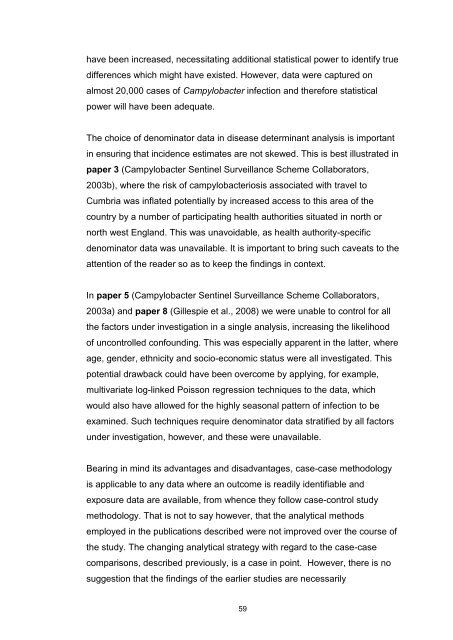PhD thesis - University of Hertfordshire Research Archive
PhD thesis - University of Hertfordshire Research Archive
PhD thesis - University of Hertfordshire Research Archive
Create successful ePaper yourself
Turn your PDF publications into a flip-book with our unique Google optimized e-Paper software.
have been increased, necessitating additional statistical power to identify true<br />
differences which might have existed. However, data were captured on<br />
almost 20,000 cases <strong>of</strong> Campylobacter infection and therefore statistical<br />
power will have been adequate.<br />
The choice <strong>of</strong> denominator data in disease determinant analysis is important<br />
in ensuring that incidence estimates are not skewed. This is best illustrated in<br />
paper 3 (Campylobacter Sentinel Surveillance Scheme Collaborators,<br />
2003b), where the risk <strong>of</strong> campylobacteriosis associated with travel to<br />
Cumbria was inflated potentially by increased access to this area <strong>of</strong> the<br />
country by a number <strong>of</strong> participating health authorities situated in north or<br />
north west England. This was unavoidable, as health authority-specific<br />
denominator data was unavailable. It is important to bring such caveats to the<br />
attention <strong>of</strong> the reader so as to keep the findings in context.<br />
In paper 5 (Campylobacter Sentinel Surveillance Scheme Collaborators,<br />
2003a) and paper 8 (Gillespie et al., 2008) we were unable to control for all<br />
the factors under investigation in a single analysis, increasing the likelihood<br />
<strong>of</strong> uncontrolled confounding. This was especially apparent in the latter, where<br />
age, gender, ethnicity and socio-economic status were all investigated. This<br />
potential drawback could have been overcome by applying, for example,<br />
multivariate log-linked Poisson regression techniques to the data, which<br />
would also have allowed for the highly seasonal pattern <strong>of</strong> infection to be<br />
examined. Such techniques require denominator data stratified by all factors<br />
under investigation, however, and these were unavailable.<br />
Bearing in mind its advantages and disadvantages, case-case methodology<br />
is applicable to any data where an outcome is readily identifiable and<br />
exposure data are available, from whence they follow case-control study<br />
methodology. That is not to say however, that the analytical methods<br />
employed in the publications described were not improved over the course <strong>of</strong><br />
the study. The changing analytical strategy with regard to the case-case<br />
comparisons, described previously, is a case in point. However, there is no<br />
suggestion that the findings <strong>of</strong> the earlier studies are necessarily<br />
59

















